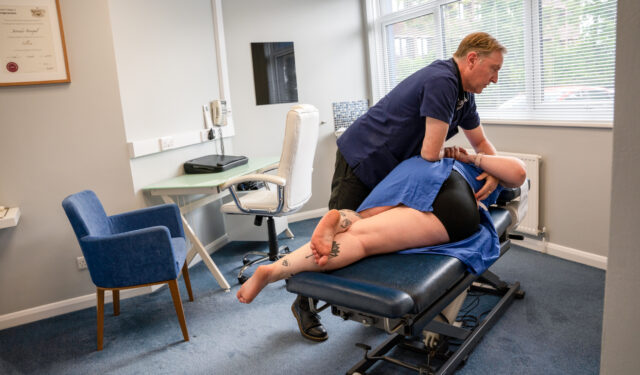
Lumbar Spinal Stenosis
Ten facts you should know about Lumbar Spinal Stenosis
Our unique approach at Isis Chiropractic Centres combines chiropractic treatment with a rigorous core stability training programme, offering a powerful solution to prevent and combat back pain.
Emphasising the importance of strong core muscles for spinal support and overall body balance, our method targets the lumbar core muscles, specifically the transverse abdominus and multifidus. Our programme provides comprehensive training in core exercises, beginning with the fundamental “abdominal hollowing” technique.
This dual-pronged strategy ensures not only alleviation from existing discomfort but also shields you against potential back-related issues, empowering you to lead a healthier, pain-free lifestyle. Trust us to guide you on this transformative journey towards improved fitness and well-being.

Want to know more? Request a Callback
Or give us a call, to find out how we can help you with Core-Muscle Exercise and Chiropractic.
Book an Appointment
Schedule an appointment for Core-Muscle Exercise and Chiropractic tailored to your needs.
If you’re following the trends in exercise and fitness, you’ve probably heard the phrase “core strength” or “core stability.” Core-muscle training is something all our patients get coached to do here at the Isis Chiropractic Centres.
The terms “core strength” or “core stability” refer to the muscles of your stomach and back and their ability to support your spine and keep your body stable, safe and balanced, which is fundamental in any physical activity, if you want to stay injury-free and perform to your potential in sport.
Don’t get tempted to progress to quickly. The biggest mistake anyone can do in core-muscle training is to do exercises that are too advanced and loosing control of the core.
If the core muscles are not able to stabilise your spine properly, other muscles will be recruited to enable you to do the exercise.
The telltale sign of weak core-muscles is the inability to keep the abdomen hollowed, the spine deviating to one side and/or the spine ‘sinking’ inwards (especially noticeable during back extension).
It can be harder than you think to this exercise properly, but when you got the hang of it, it is definitely worth it. So, don’t give up even if it seems impossible to start with.
Chiropractic treatment and core-muscle training is such a powerful combination to beat back pain. Don’t loose out by only using one or the other!
The lumbar core muscles lie deep within the trunk of the body. They generally attach to the spine, pelvis and muscles that support the shoulder blade (scapula).
(There are core muscles in the mid-back and the neck too, but this page will mainly discuss the lumbar core muscles.)
They stabilise these areas to create a firm foundation for co-ordinated movement of the legs and arms.
Two muscles in particular have been shown to be weak in those who have or have had low back pain:
These muscles are deep in your low back and stomach. You can’t readily feel them from the surface.
Because good balance and overall muscular strength are involved in most sports, core stability is helpful for all athletes. However, there are some sports where good core stability is especially important.
These include sports where you need very good balance, contact or collision sports, such as:
Core stability is also needed in everyday life: helping to keep you fit and to prevent injury when you are lugging those heavy shopping bags or doing the ironing.
Rises in back pain incidence have been linked to the sedentary lifestyle that many of us lead and as chiropractors we always try to motivate our patients to exercise.
Core-stability training begins with learning to co-contract the transverse abdominus (TA) and multifidus (MF) muscles effectively as this has been identified as key to the lumbar-support mechanism.
We recommend all our chiropractic patients to start this exercise as early as possible.
To perform the TA and ME co-contraction, you must perform the “abdominal hollowing” technique with the spine in the neutral position.
To do this use the following guidelines:
Bear in mind the following points:
In each position get your lumbar spine into neutral before you perform the hollowing movement.
Once you start to feel that you have good control of this exercise you can start to do other core-stability exercises.